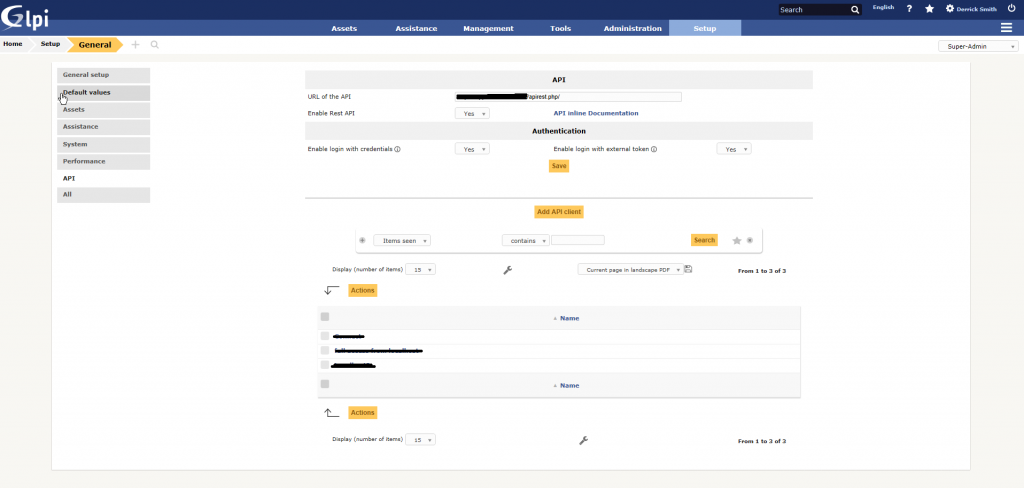This post is an update to an earlier post regarding integrating Nagios with GLPI that can be found here. Due to recent improvements in the GLPI distribution I decided to rewrite the eventhandlers. You can find a link to GitHub at the bottom of this post.
One of the key pillars of information security is availability of resources and as a proponent of using open source solutions whenever possible I have chosen to utilize Nagios for monitoring and GLPI for helpdesk solutions. Nagios provides powerful monitoring capabilities for equipment, hosts and services but doesn’t integrate with ticketing systems directly which can make tracking and reporting difficult. GLPI is an ITIL based helpdesk solution that provides asset and incident/request management. It offers generous reporting out of the box and a webservices API that can be used to extend the system. When used together these two systems can provide a way to track host and service availability and a way to report on the health and resolution metrics of those systems over time.
As shown in my previous post regarding the integration of Nagios and GLPI, the marriage of the two systems is done using the built-in Nagios eventhandler action and the GLPI webservices API. In previous versions of GLPI, a webservices plugin was used to create the API endpoints. As of GLPI version 9.1, a webservices API is included in the core package. The following procedure for integrating GLPI with Nagios will only work with GLPI 9.1+. The event handlers have also been improved and use an object oriented approach. The PHP xml_rpc extension has been replaced with the curl extension. Be sure curl is installed before using these scripts.
GLPI Configuration
First, enable the API and create an API client on the API Settings page in GLPI located under Setup > General > API. Enable both Authentication settings to allow your API client to login with credentials and an authentication key. Be sure to copy the API URL and the API key for the client. Although the event handler scripts can use any GLPI account that has ticket creation permission to create new tickets, it is recommended to create a new user account that will be used specifically for API transactions.
Nagios Configuration
Depending on the version of Nagios and the base operating system, Nagios could be installed into several possible locations. I typically use Ubuntu Server and the directories listed below are for Nagios3 – your directories may be different.
First, open the host and service event handlers and change the variables at the top of each script to reflect your environment. The scripts include the following variables:
## Required ##
$glpi_user = '';
$glpi_password = '';
$glpi_apikey = '';
$glpi_host = '';
$nagios_host = '';
$verifypeer = FALSE; // SETS curl_setopt ($curl, CURLOPT_SSL_VERIFYPEER, FALSE);
$logging = TRUE;
$critical_priority = 5;
$warning_priority = 3;
## Optional ##
$glpi_requester_user_id = '';
$glpi_requester_group_id = '';
$glpi_watcher_user_id = '';
$glpi_watcher_group_id = '';
$glpi_assign_user_id = '';
$glpi_assign_group_id = '';
The initial variables are self-explanatory. The ssloff variable should be set to true if your site is http, you are using a self-signed certificate for https or your ssl configuration prevents successful certificate validation. The optional variables are used to control how new tickets are opened and if initial watchers and ticket owners are used. Use these variables to control which groups or users are notified of new tickets and when tickets are closed.
After you have modified the scripts, copy them and the glpi_api class to the Nagios eventhandler directory. Next, modify the Nagios commands.cfg file to include the following commands. Be sure to replace the directory with the correct event handler directory for your Nagios installation.
# 'manage-host-tickets' command definition
define command{
command_name manage-host-tickets
command_line php /usr/share/nagios3/plugins/eventhandlers/manage-host-tickets.php hoststate="$HOSTSTATE$" hoststatetype="$HOSTSTATETYPE$" eventhost="$HOSTNAME$" hostattempts="$HOSTATTEMPT$" maxhostattempts="$MAXHOSTATTEMPTS$" hostproblemid="$HOSTPROBLEMID$" lasthostproblemid="$LASTHOSTPROBLEMID$"
}
# 'manage-service-tickets' command definition
define command{
command_name manage-service-tickets
command_line php /usr/share/nagios3/plugins/eventhandlers/manage-service-tickets.php servicehost="$HOSTNAME$" servicestate="$SERVICESTATE$" servicestatetype="$SERVICESTATETYPE$" hoststate="$HOSTSTATE$" eventhost="$HOSTNAME$" service="$SERVICEDISPLAYNAME$" serviceattempts="$SERVICEATTEMPT$" maxserviceattempts="$MAXSERVICEATTEMPTS$" lastservicestate="$LASTSERVICESTATE$" servicecheckcommand="$SERVICECHECKCOMMAND$" serviceoutput="$SERVICEOUTPUT$" longserviceoutput="$LONGSERVICEOUTPUT$"
}
Next, modify your host and service templates to include the above event handler commands,
define host{
name generic-host ; The name of this host template
notifications_enabled 1 ; Host notifications are enabled
event_handler_enabled 1 ; Host event handler is enabled
flap_detection_enabled 1 ; Flap detection is enabled
failure_prediction_enabled 1 ; Failure prediction is enabled
process_perf_data 1 ; Process performance data
retain_status_information 1 ; Retain status information across program restarts
retain_nonstatus_information 1 ; Retain non-status information across program restarts
check_command check-host-alive
event_handler manage-host-tickets
max_check_attempts 1
notification_interval 0
notification_period 24x7
notification_options d,u,r
contact_groups admins
register 0 ; DONT REGISTER THIS DEFINITION - ITS NOT A REAL HOST, JUST A TEMPLATE!
}
define service{
name generic-service ; The 'name' of this service template
active_checks_enabled 1 ; Active service checks are enabled
passive_checks_enabled 1 ; Passive service checks are enabled/accepted
parallelize_check 1 ; Active service checks should be parallelized (disabling this can lead to major performance problems)
obsess_over_service 1 ; We should obsess over this service (if necessary)
check_freshness 0 ; Default is to NOT check service 'freshness'
notifications_enabled 1 ; Service notifications are enabled
event_handler_enabled 1 ; Service event handler is enabled
flap_detection_enabled 1 ; Flap detection is enabled
failure_prediction_enabled 1 ; Failure prediction is enabled
process_perf_data 1 ; Process performance data
retain_status_information 1 ; Retain status information across program restarts
retain_nonstatus_information 1 ; Retain non-status information across program restarts
notification_interval 0 ; Only send notifications on status change by default.
event_handler manage-service-tickets
is_volatile 0
check_period 24x7
normal_check_interval 5
retry_check_interval 1
max_check_attempts 4
notification_period 24x7
notification_options w,u,c,r
contact_groups admins
register 0 ; DONT REGISTER THIS DEFINITION - ITS NOT A REAL SERVICE, JUST A TEMPLATE!
}
After you are finished be sure to restart the Nagios service. You will now receive helpdesk tickets in GLPI when alerts are created in Nagios and those tickets will be removed when the service or host has been restored. GLPI will handle the appropriate notifications.

